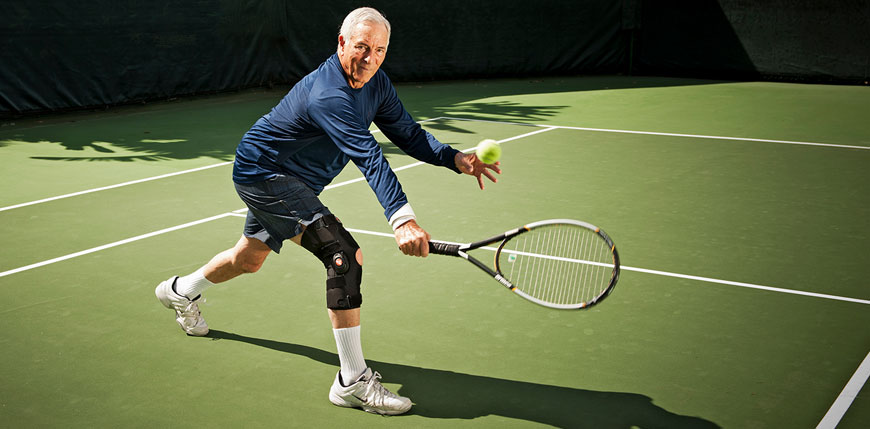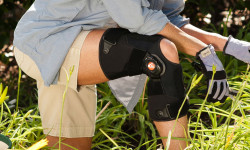Dynamic Bracing - A New Frontier
Dynamic braces are an entirely new category of bracing pioneered by Bledsoe Brace Systems.
These braces use muscle powered leg movement to translate a hinge lever, shell, or strap that works against a particular pathological movement or condition. First, It is necessary to understand the pathology that exists in the knee (e.g. tibial subluxation, medial or lateral joint space opening from thrusting osteoarthritis, or varus deformity), and then to design a brace which works against pathological movement at a certain point within the range of motion. Dynamic braces use the power of the muscles to pre-compress the soft tissue in order to achieve high forces that are necessary to control specific pathological conditions. The tension can sometimes be adjusted to produce forces high enough to briefly limit circulation. However, as soon as the leg is moved out of this high force position the forces are reduced and circulation is restored. These braces are patient adjustable to permit just the right amount force to eliminate sensations of instability, pain, and certain symptoms. The patient can optimize the force to create a balance between reduction of symptoms and comfort.
In addition to the mechanical support provided by a brace, there is also a much larger benefit from increases in proprioception and joint position sense. In fact, for some passive or static counter force braces the proprioceptive effect may be the overwhelming benefit. All functional braces to some extent act as external bio-feedback devices to provide information that helps the patient overcome confusion in his force and muscle pattern systems. The proper combination of stiffness and flexibility as well as the appropriate points of contact from the condyle pads and straps optimize this effect. Dynamic braces produce a variable force as the leg is extended and flexed which provides greatly increased information on the position of the knee compared to passive or static counter force braces. Furthermore, it is virtually impossible to mechanically limit certain types of pathological movements due to soft tissue deflection unless special mechanisms (such as a dynamic brace or a smart brace using a muscle stimulator) are utilized to pre-compress the soft tissue.
An important contribution of a brace is the ability to recognize when a force is placed on the body earlier than can be recognized through the mechanoreceptors in the connective tissue. It requires a certain amount of time to perceive excessive strain in the connective tissues, because the body must differentiate between normal strain and the excessive strain created by a specific maneuver. However, as abnormal motions occur, the body runs into the brace causing an increase in force that is obviously different from the normal feel of the brace. This creates an early perception of the force, and opens the front-end of the perception window. It also requires a certain amount of time for the muscles to react and the peak torque of the muscle to be achieved. If the force rises too rapidly for the muscles to counteract, the result can be failure of some connective tissue structure. Braces tend to slow the rate of loading. In other words, the brace stiffness (up to a limit) slows down the rate at which the movement occurs. This gives more time for the muscles to react opening the back end of the perception window. The result is an increased ability to perceive and react to certain forces when wearing a brace. The majority of patients (92 %) exhibit increased confidence, decreased pain and swelling, more rapid return to sports play, decreased incidence of giving way, and decreased sensations of instability when wearing functional braces. If we realize that the mechanical effectiveness of the brace to prevent injury is sometimes questionable, then we must also realize that some other effect is creating these patient benefits.
Most patients do not absolutely require braces any more than they absolutely require ACL reconstructions. Many patients can modify their activity and get along just fine without the reconstruction. However, highly athletic individuals can perform better at a higher activity level for a longer period of their life with the reconstruction than without. The same is true for braces. The patients are more comfortable, more certain about their movements, and both physically and psychologically more protected when wearing a brace than without. The increased perception window alone makes it worthwhile for many patients to wear a brace. Furthermore, for 33% of the patients, a brace may be necessary to help compensate for a lack of kinesthetic awareness and compensatory capability that results in quadriceps inhibition and continued atrophy.
Following ACL reconstruction, a reasonable percentage of patients never recover their quadriceps strength or overcome quadriceps inhibition. The reconstructed ACL is at increased risk of failure or stretching due to lack of a primary reflex arc in the hamstring muscles. The graft has no mechanoreceptors to trigger the hamstring reflex. Until ligament maturation is almost complete the muscle and force patterns cannot be rebuilt in a stable fashion. The muscle and force patterns must be built on a stable platform not a moving target.
Physicians can permit patients to return early to sports play without a brace, but they can not change the fact that the patient has an increased risk of failure or stretching with no sensory input from the reconstructed ACL. In fact, some patients may never compensate for the lack of neuro-sensory input from the original ACL. These patients are forever at risk unless the hamstrings muscles are re-trained to remove the strain from the ACL graft as the leg is rapidly extended during open kinetic chain maneuvers such as landing from a jump, running downhill, stopping, or lateral moves.
There is a great deal more to understanding functional braces than simply selecting the lightest and prettiest from a brace tree. It depends a great deal on the patient’s proprioception, muscle tone, athletic ability, and the amount of soft tissue present. It also depends on the correct design and proper placement of the brace, as well as the ability to change shape slightly with the changing leg shape. Proper placement of straps, adequate leverage, sufficient surface contact area, and the ability to remain in the proper place are very important factors in proper brace function. Lightweight and comfort are also key ingredients in the patient’s acceptance of the brace. The true challenge is not whether to brace or not, but in learning which patients can gain the greatest benefit from the proper type of functional brace.




